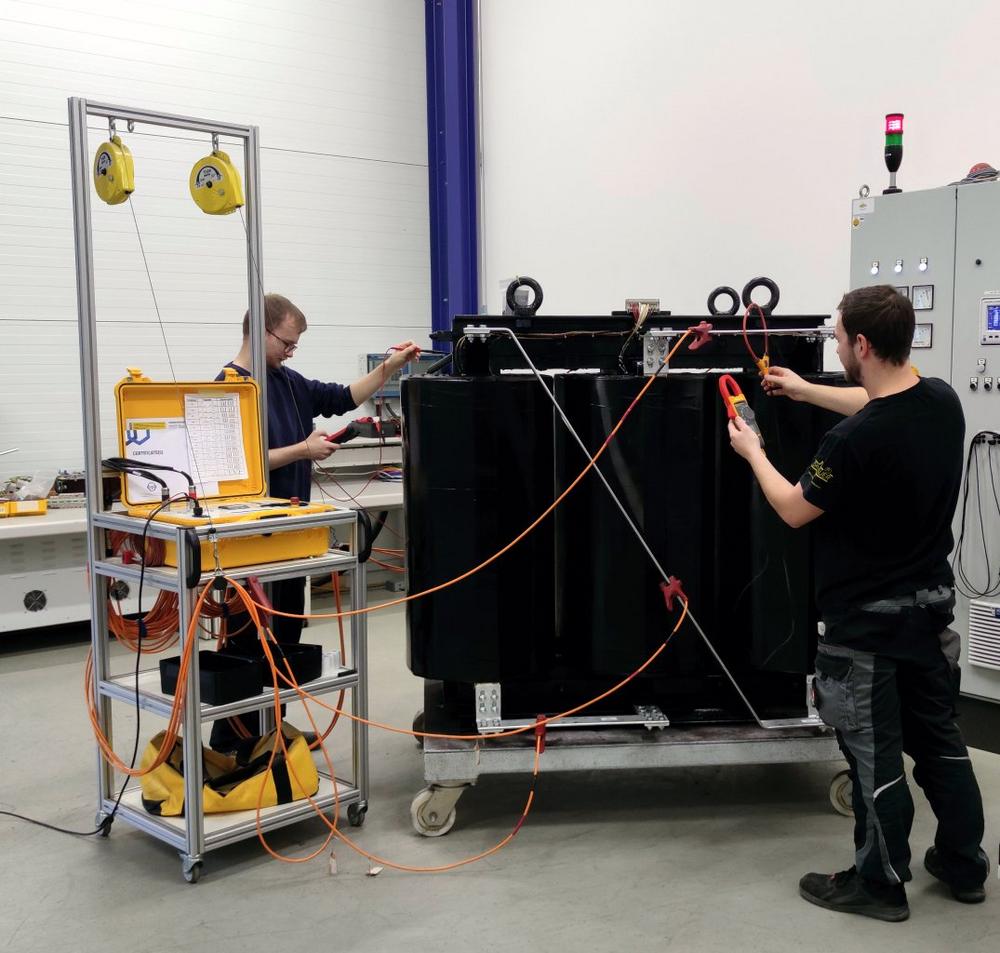The resource-optimised 3-phase isolating transformer is used in the low-voltage test field of power electronics for wind turbines. Its task is to galvanically separate two circuits and at the same time prevent common-mode interference from being transmitted. The efficiency is a record-breaking 99.4% with a maximum output of 2.7 MVA. Thanks to its resource- and cost-saving design without copper, the transformer weighs less than 5,500 kg. Its waste heat is dissipated by forced cooling. Alternatively, up to 2.5 MVA, heat dissipation via natural convection would be possible. In the power classes above that, cooling is either by water or forced air.
Aluminium transformers can be designed with very high efficiencies. In the power range above 200 kVA, over 99% is achievable even with standard materials. Al transformers make optimum use of the raw materials due to their design and thus save valuable resources. They are considerably lighter and cheaper than comparable copper transformers.
The conductivity of aluminium is about 65% of copper, which is why aluminium transformers require higher cross-sections in the windings in direct comparison. On balance, however, the weight and cost advantages are in the lead: On the basis of the same conductance values, aluminium wire is 50% lighter – and costs only about 15% of copper.
In transformer design, the weight and cost advantages are somewhat relativised. Depending on the efficiency, the achievable weight advantage is about 20% compared to copper. In addition, aluminium behaves differently, has a different coefficient of expansion, and therefore requires more care in the production of transformers.
Schmidbauer has already manufactured Al transformers with several voltage levels and protection classes up to IP66. It is possible to build up transformers as autotransformers, as well as any switching groups such as Dyn5, Dyn11, YNyn0, Yd5, Dd0 etc.
It should not be concealed that there are also applications in which copper transformers are superior to their inexpensive and lightweight aluminium counterparts. Schmidbauer offers honest and fair advice in this context, as the company is proficient in both technologies.
Further information under:
https://www.schmidbauer.net/en/aluminium-transformer/aluminium-transformer/
Founded in 1949 in Hebertsfelden, Lower Bavaria, about 80 km east of Munich, the family-run Schmidbauer Group of Companies today is a leading global specialist in inductive components. At two locations, around 240 employees develop and manufacture all kinds of winding components, from small RF coils to large filter chokes, from regenerative mains filters to customised power supplies – including for the world’s largest particle accelerator at CERN.
A top-class development department is constantly exploring the limits of inductive components and makes the company a sought-after partner worldwide for the development of energy-efficient drives for electromobility, but also generally for power electronics used in machine tools – or in test centres for battery production. Several years ago, water cooling, for example, was considered to be some form of a "nutcase". Today, it has not only arrived in general power electronics applications, but has become a standard.
Numerous research projects and awards underline the innovative character of the family-owned company. Since 2010, the company has been continuously investing in sustainability and working to further reduce the ecological footprint of its products.
Schmidbauer Transformatoren u. Gerätebau GmbH
Spanberg 16
84332 Hebertsfelden
Telefon: +49 (8721) 9662-0
Telefax: +49 (8721) 9662-50
http://www.schmidbauer.net
Marketing
E-Mail: vr@robologs.com
![]()

